Key takeaways:
- gRPC enhances API performance and reduces latency through efficient data serialization with Protocol Buffers and supports real-time, bi-directional streaming.
- Strong API contracts established through interface definitions improve versioning and reduce errors in microservices architecture.
- Choosing between gRPC and REST depends on application needs; gRPC is ideal for low-latency, real-time applications, while REST suits simpler CRUD operations.
- Implementing best practices like proper endpoint design, versioning, and performance monitoring fosters reliable service communication and enhances user experience.
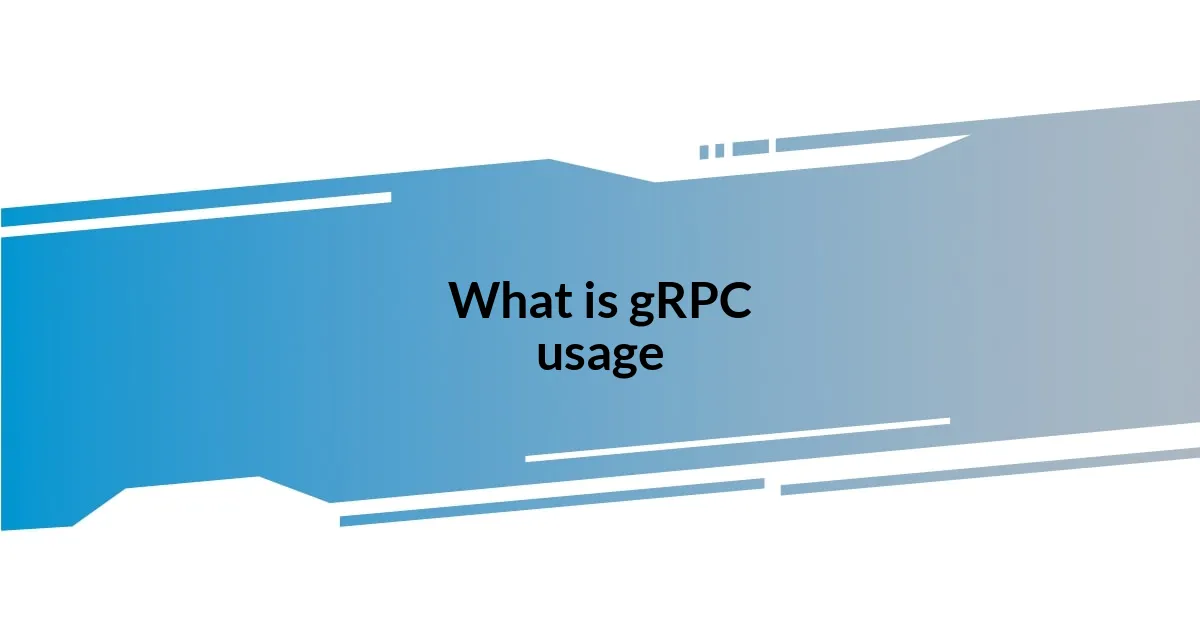
What is gRPC usage
gRPC, which stands for Google Remote Procedure Call, is a modern framework for building efficient APIs that allows services to communicate seamlessly over a network. When I first started using gRPC, I was struck by how much it streamlined the process of service communication, especially in microservices architectures. Have you ever faced frustrating latency issues with traditional REST APIs? With gRPC’s use of Protocol Buffers for serialization, I noticed a marked improvement in data transmission speed and efficiency.
One of the standout features of gRPC is its support for bi-directional streaming. This means that clients and servers can send messages back and forth in real time. Just the other day, while developing a chat application, the ability to push messages instantly made all the difference. It’s exhilarating to see how communication can happen fluidly, rather than waiting for one side to finish before the other can respond.
Another aspect of gRPC usage that resonates with me is how it encourages strong API contracts through the use of interface definitions. I once struggled with maintaining consistent API behaviors across different versions; it felt like a juggling act. However, once I embraced gRPC, the strict typing and clear method definitions gave me a newfound confidence in how services interacted, reducing the headaches that came with breaking changes. Isn’t it refreshing when a tool not only works but also simplifies your workflow?
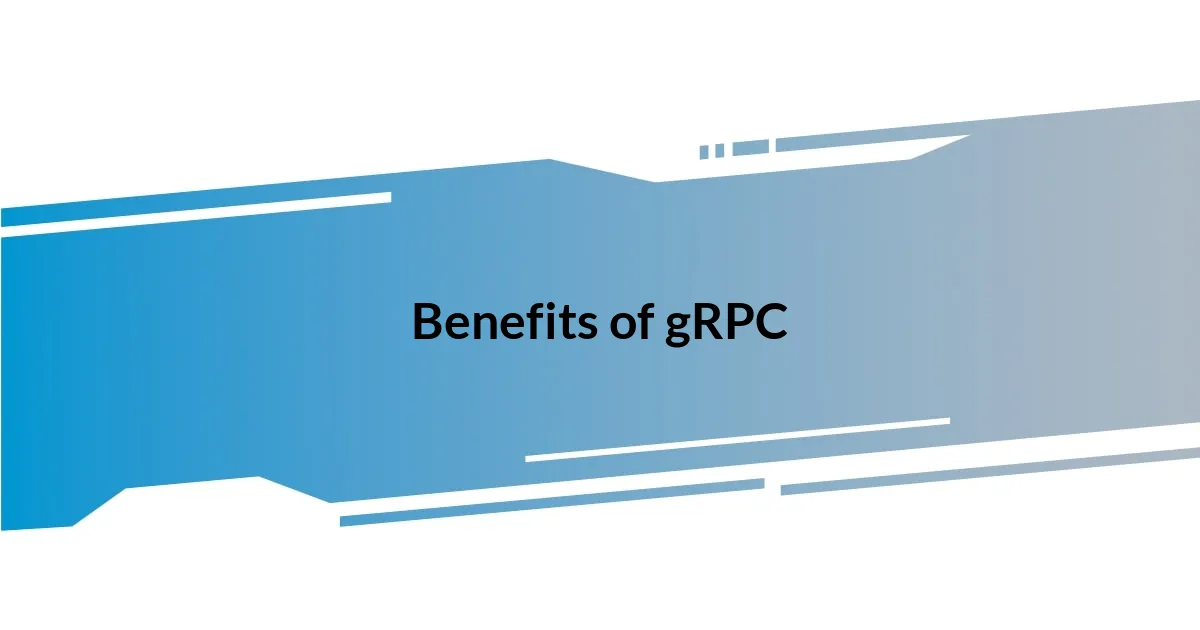
Benefits of gRPC
The benefits of gRPC are quite impressive, especially when you consider the significant performance gains it offers. From my experience, the switch to gRPC drastically reduced the latency in my applications. I remember when I integrated gRPC into a data-heavy application; it felt like I was unlocking a hidden level of optimization. Instead of experiencing sluggish API calls, everything became responsive and snappy, which not only improved user experience but also boosted overall productivity.
Here are some standout benefits of gRPC that I’ve come across:
- Efficiency: The use of Protocol Buffers for serialization enhances data transfer speeds, minimizing latency.
- Bi-directional Streaming: This feature allows for real-time communication, which I’ve found invaluable in applications requiring instant feedback or updates.
- Strong API Contracts: The clearly defined interface ensures better versioning and consistency across services, providing peace of mind during development.
- Multi-language Support: gRPC enables communication between services written in different programming languages, which is a game changer in a polyglot environment.
- Built-in Authentication: The framework has robust security measures, allowing for easier implementation of secure communications.
Using gRPC has not only improved my workflow but has also truly transformed the way I approach API design. It’s inspiring to witness such seamless integration and powerful communication capabilities. Our modern applications deserve nothing less!
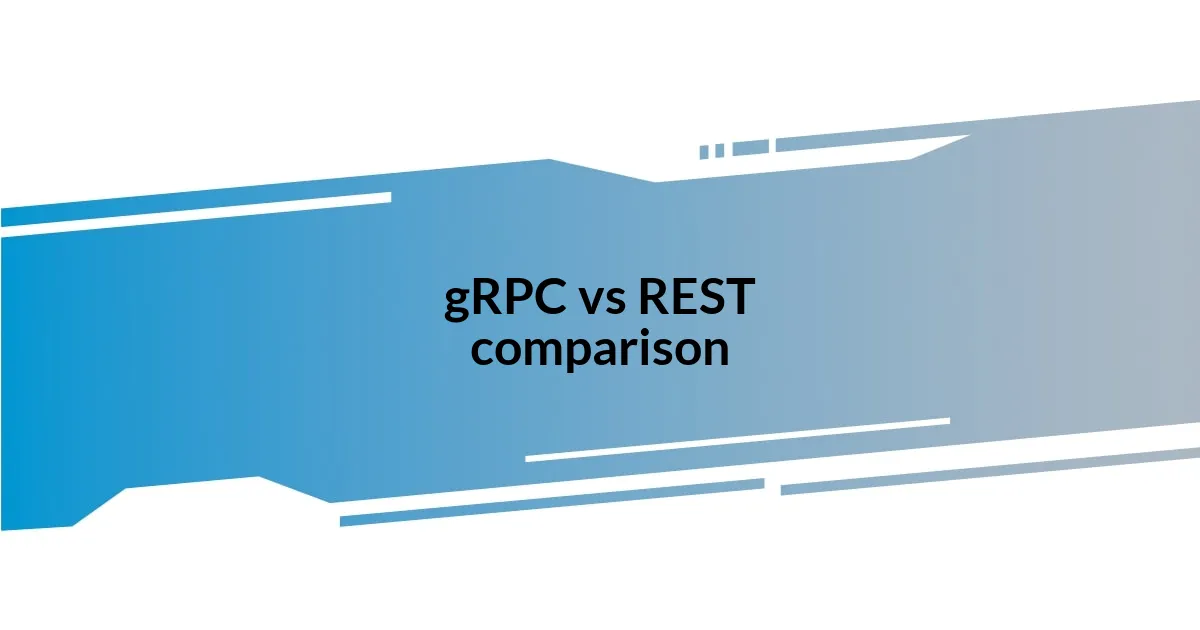
gRPC vs REST comparison
When comparing gRPC and REST, I often think about the fundamental differences in their architectures. gRPC uses a binary protocol, which can be a bit intimidating at first, but once I got the hang of it, I realized how much faster and efficient it was compared to REST’s text-based JSON. It struck me during one intense coding session; switching to gRPC for our data exchange not only improved performance, but also freed up more resources for computation. Have you ever had that moment where everything just clicks into place? That’s what gRPC felt like for my projects.
Another key difference is the way each framework handles communication. While REST is typically request-response oriented, gRPC’s support for streaming allows for continuous data flow. I vividly remember working on a real-time analytics dashboard; gRPC’s ability to push data instantly transformed how we approached user interactions. Suddenly, data was available without delay, creating a more engaging experience for users. It’s moments like these that emphasize how the choice between gRPC and REST can truly impact application performance and user satisfaction.
Overall, understanding the implications of choosing between gRPC and REST is crucial for developers. I’ve always found that evaluating the specific use cases of a project guides this choice. For instance, if your application needs low latency and real-time communication, gRPC should be at the forefront of your thoughts. On the other hand, if you’re dealing with simpler CRUD operations where compatibility is key, REST might just do the trick. This decision-making process reminds me of selecting the right tool for a job—each tool has its strengths, and it’s up to us to leverage them wisely.
| Feature | gRPC | REST |
|---|---|---|
| Protocol | Binary Protocol | Text-based (JSON) |
| Performance | Higher Efficiency | Variable Efficiency |
| Data Transmission | Streamed (Bi-directional) | Request/Response |
| Use Case | Real-time applications | Simpler web services |
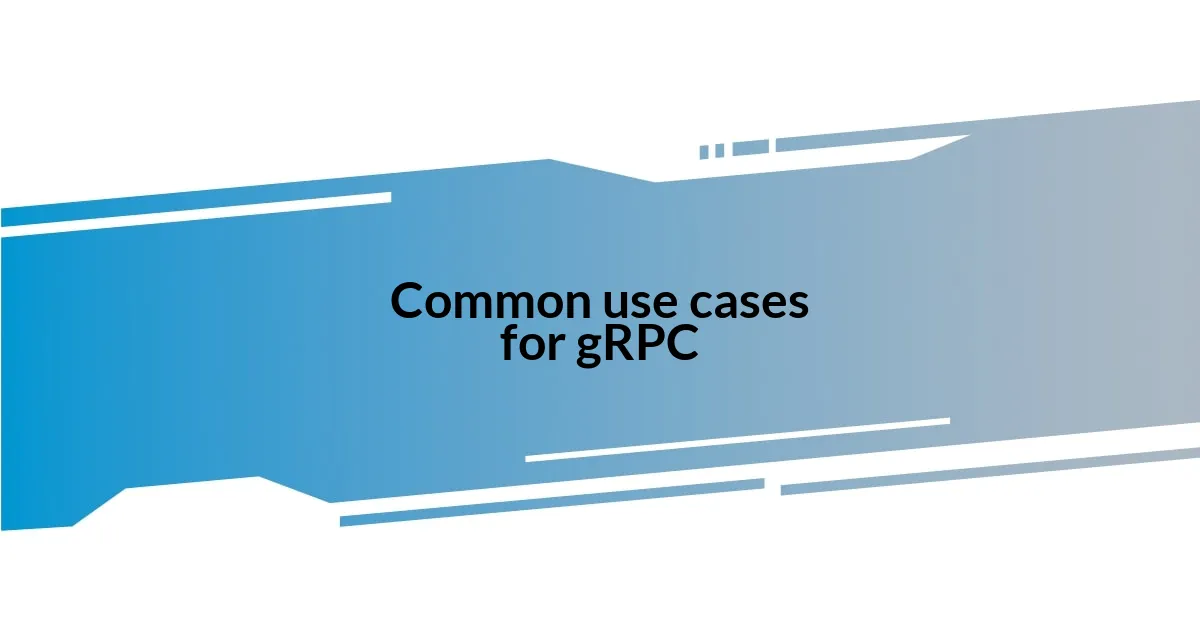
Common use cases for gRPC
In my experience, one of the most compelling use cases for gRPC is in microservices architecture. When I worked on a project that spanned multiple services, the seamless communication between them was crucial. With gRPC, I noticed how easy it was to define service contracts using Protocol Buffers. This clarity helped my team avoid those frustrating discrepancies and speed up development. It’s almost like gRPC became the glue holding our services together, enhancing collaboration and reducing errors.
Another fascinating aspect of gRPC is its role in real-time data processing. I recall a situation where I needed to implement a chat application. Using gRPC’s bi-directional streaming capabilities made it a breeze to send and receive messages instantly. I still remember the thrill of seeing the messages pop up in real time without any lag. That’s the magic of gRPC – it enables dynamic interactions that simply aren’t possible with traditional RESTful approaches. Have you ever experienced that rush when a feature works exactly as you envisioned?
Lastly, gRPC shines in scenarios requiring complex data interactions, such as in data-heavy applications. For instance, I once integrated gRPC into a machine learning model that processed vast amounts of data. The reduction in latency was astonishing—I went from waiting for responses to near-instant feedback loops. Such performance improvements reminded me how vital it is to choose the right tools for data-sensitive applications. When you see your system respond as quickly as your thought process, it’s an exhilarating experience that reaffirms why I advocate for gRPC in the right contexts.
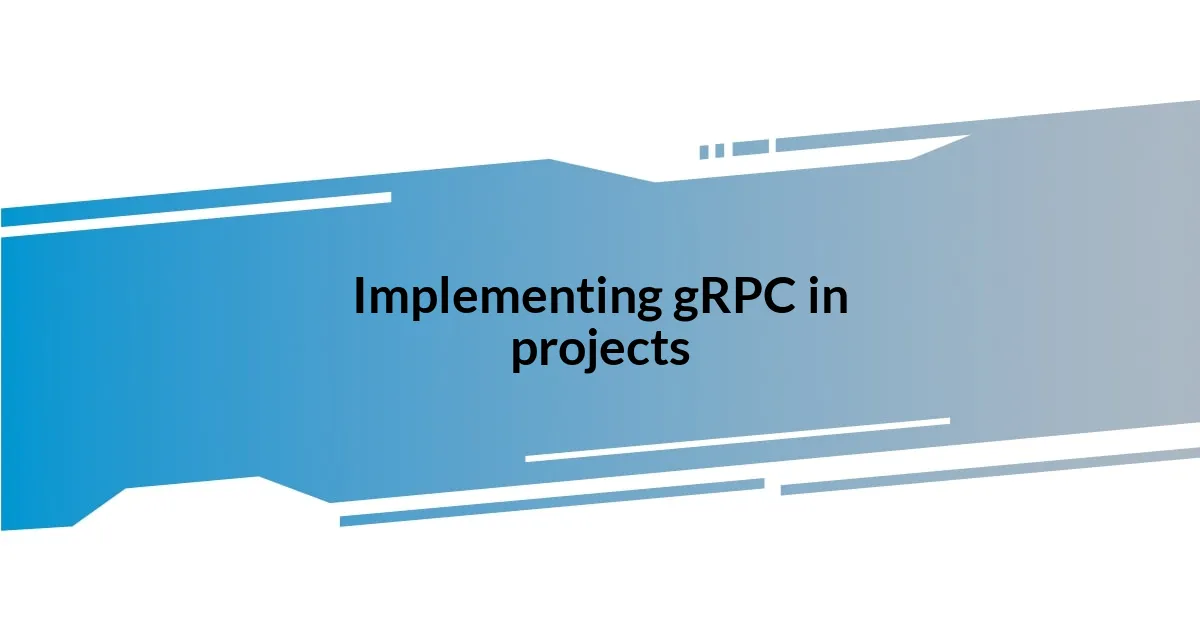
Implementing gRPC in projects
Implementing gRPC in projects has been a transformative experience for me, particularly in how it organizes service definitions. I remember diving into a multi-team project where we faced integration issues, and adopting gRPC allowed us to define clear service contracts with Protocol Buffers. It brought a sense of order and understanding—almost like building a roadmap for our services. Have you ever felt the relief that comes from clarity? That’s what I experienced as we streamlined our processes and enhanced communication.
In my recent projects, I’ve found that gRPC shines when it comes to performance optimization. I worked on a backend service that required lightning-fast interactions with a database. By leveraging gRPC’s streaming abilities, I could fetch and send large datasets effortlessly. It’s fascinating to think about how what used to take seconds of wait time transformed into near-instantaneous interactions. Isn’t it incredible how a small change in technology can lead to such a significant impact on performance?
Another aspect of implementing gRPC that excited me was its built-in support for load balancing and authentication. There was a pivotal moment when our application faced a surge in traffic, and the ability to easily scale services with gRPC helped us manage the load seamlessly. I felt a wave of pride as our system remained robust and reliable under pressure. Have you ever wished you could assure your clients that everything would run smoothly even during peak times? gRPC gave me that peace of mind, reinforcing my belief in its advantages for robust, large-scale applications.
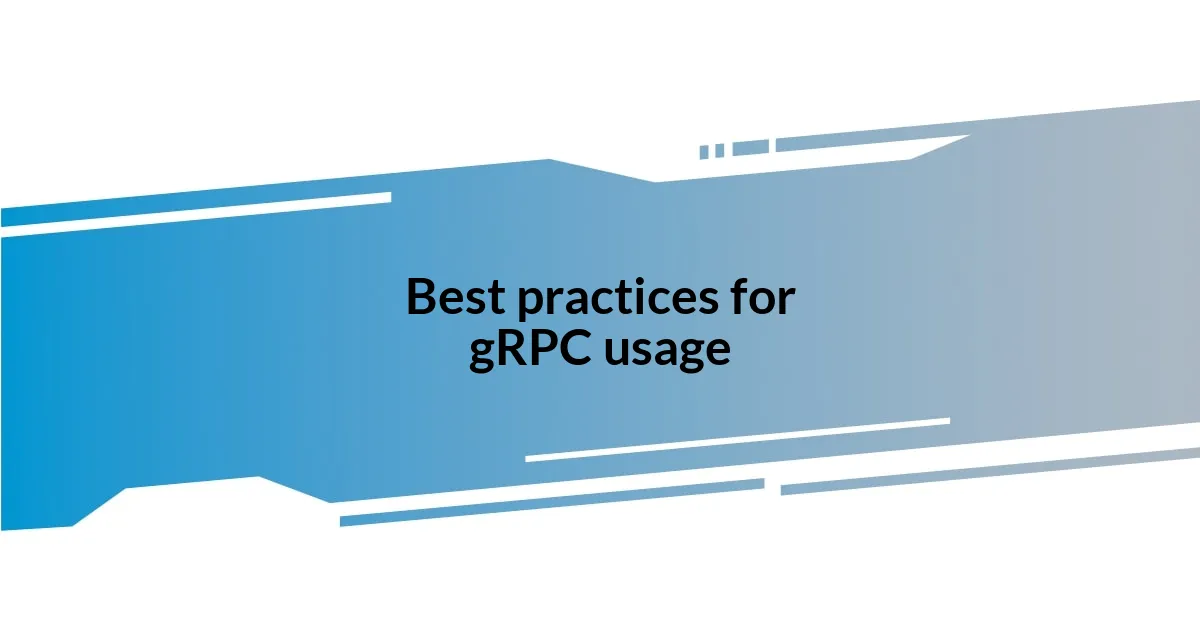
Best practices for gRPC usage
Adopting gRPC requires a good grasp of effective service design. During one of my projects, I learned that taking the time to properly structure service endpoints can significantly reduce complexity later on. I vividly remember the initial confusion when endpoint design was rushed—it led to tangled dependencies that snowballed into bigger issues. Does this sound familiar? Proper planning allowed us to avoid those pitfalls, and it felt like finally untangling a knot after pulling at it ineffectively.
Another best practice I value is the importance of versioning your APIs. I recall a situation where a non-versioned API update disrupted existing clients, causing frustration among users. Incorporating versioning not only provided a safety net but also fostered trust with my clients, reassuring them that we prioritized their needs. When making changes, it’s crucial to treat the client as the primary concern, don’t you think? This small practice turns out to be a game-changer in maintaining a smooth experience for users.
Lastly, always monitor your gRPC calls for performance and error handling. I once overlooked this during a high-stakes project, and it resulted in some surprising latency issues that impacted user satisfaction. Since then, I’ve been diligent about implementing observability hooks, letting me dive deep into performance trends and catching errors before they escalate. Have you ever wished you could anticipate issues before they even arise? By keeping a close eye on gRPC metrics, I learned to proactively enhance performance and ensure the reliability that users expect.
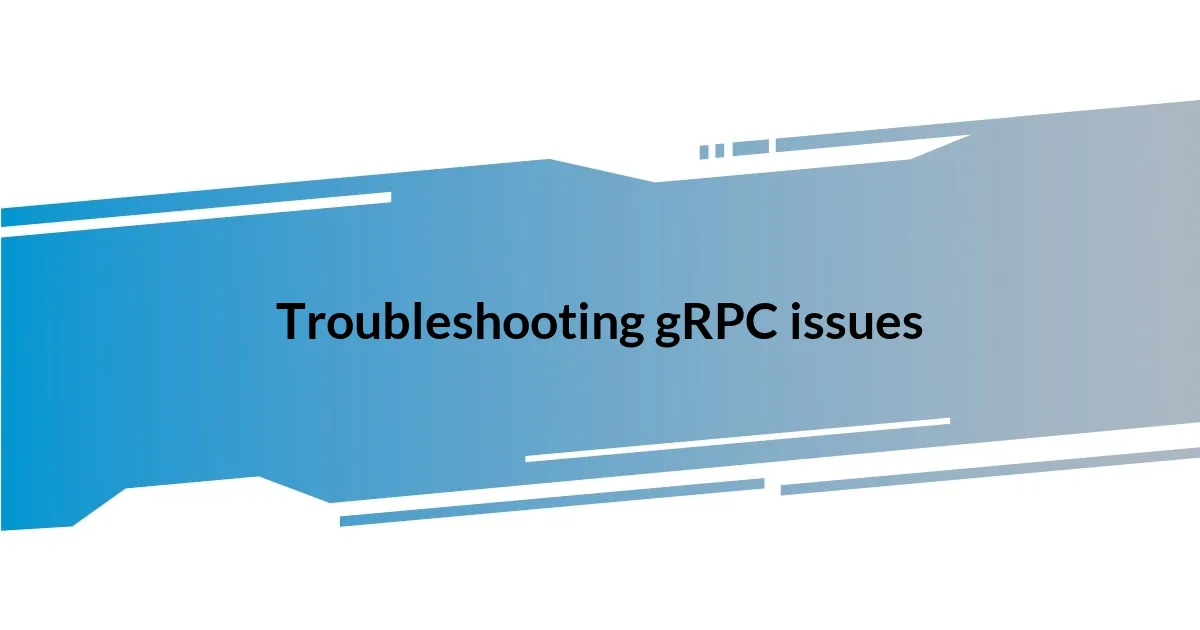
Troubleshooting gRPC issues
When troubleshooting gRPC issues, I often find that starting with the basics makes a world of difference. During one of my earlier projects, we encountered frequent connection failures, which brought our development to a standstill. It turned out that a simple misconfiguration in our service’s DNS setup was the culprit—fixing it was like lifting a weight off my shoulders. Have you ever felt that instant relief when a small oversight is resolved?
Another common pitfall I’ve faced is related to error handling in gRPC calls. I vividly remember a project where we overlooked gracefully handling timeouts. The end users of our application experienced unexpected crashes, and the fallout was frustrating for everyone involved. Since then, I’ve made it a priority to implement proper error handling, which has transformed my approach to resilience in service communication. Isn’t it incredible how thorough error management can safeguard user experience?
Finally, I advocate for utilizing the built-in gRPC logging and tracing capabilities. I once struggled to diagnose slow response times and found myself wading through log files, feeling overwhelmed. However, integrating gRPC’s tracing features allowed me to visualize call paths and pinpoint bottlenecks instantly. It was a game changer! Have you experienced the satisfaction of uncovering a solution that seemed elusive? I certainly have, and it underscored how essential these tools are for maintaining a clear view of how services interact.